Rose of Sharon (Althea Shrub Plant) Grow & Care Guide
Written by Iris
Nov 25 2022
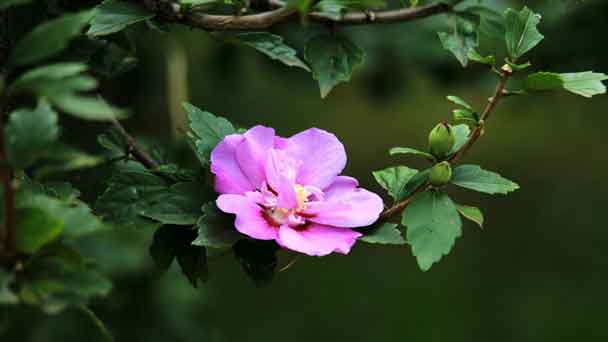
Rose of Sharon (Althea Shrub) is a hibiscus shrub or small tree that produces beautiful red, white, pink, light blue or lavender flowers. Many gardeners like Rose of Sharon because it produces amazing flowers when few shrubs bloom in late summer. It's also easy to take care of the salon plant's roses, which survive well through most winters. Rose of Sharon (Althea Shrub) is a great shrub to use as a privacy hedge or foundation shrub.
Where to Grow Rose of Sharon
Full sun to partial afternoon shade. An area with good air circulation Rose of Sharon produces the best flowers and strongest stems, and is the best environment to prevent disease. Keep an eye out for hot, scorching afternoon sun that may burn the foliage; as well as provide protection from damaging wind.Growing Tips
- Plant in nutrient-rich, well-draining soil.
- Select a spot with full sun that is protected by a wall, structure, or hedge.
- Mulch effectively to maintain moisture retention and a cool environment for the roots.
- Consider wrapping the plants in burlap for winter protection if you live in Zone 5 or starting them indoors your first year.
- In Zones 5 and 6, it is particularly crucial to provide protection from the chilly winter winds.
When to Grow Rose of Sharon (Althea Shrub)
If you are adding rose of Sharon shrubs to your garden, you should plant them in the spring or fall. Because they are a good hedge plant, plant them 6 to 10 feet (1.8 – 3 m) apart, depending on your landscaping goals. You can also grow rose of Sharon from seeds by planting the seeds outdoors in late winter about 12 weeks before the last frost date. They should be planted in sunny spots and require deep watering.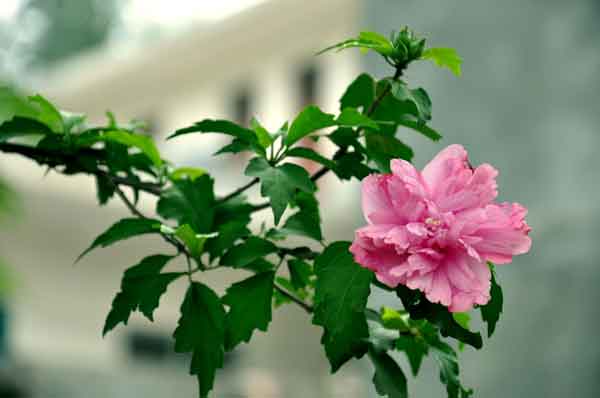
How to Grow Rose of Sharon (Althea Shrub)
Grow Rose of Sharon from Seeds
It is easier to propagate from seed, however the offspring are not true to type. Harvest the seeds in fall just before they are fully mature and sow them directly into the planting bed outdoors. You can also store the seeds in a dry place over winter and sow them in spring. If so, soak the seeds in water for around 24 hours. Then sow the seeds into sowing substrate in a seed tray, lightly press into the soil using a board and sift a little sand over them. The seeds start to germinate after 4 to 10 days and can be pricked out into pots a few weeks later. After around three years, the young Rose of Sharon can be planted in the garden.Grow Rose of Sharon from Cuttings
Rose of Sharon is propagated through cuttings. You can do so at any time of the year. But there are a few things you need to remember if you want to grow another bush in your yard. For instance, take green cuttings during summer and wooden cuttings in fall or winter. The wooden cuttings should be at least one year old. Aim for 4 to 6-inch cutting. All leaves except for the top ones should be removed.If you are propagating the rose of Sharon in summer, you can take the fresh cutting and place it directly into the ground. The soil needs to be moist and fertilized. Keep watering the new plant frequently, and it should develop the root system in no time.
Generally, the safest way to propagate rose of sharon is to place a fresh cutting into a pot. Use a rooting hormone on the bottom part of the stem and place the lower half into a pot. Water the cutting and cover it up with clear plastic.
The pot should be kept in shade or indirect sunlight. Remove the plastic after one week. Keep the soil moist but not too much. The root system will develop after one or two months. You can check by pulling the plant up. Also, if you see new leaves, the cutting is adapting and growing.
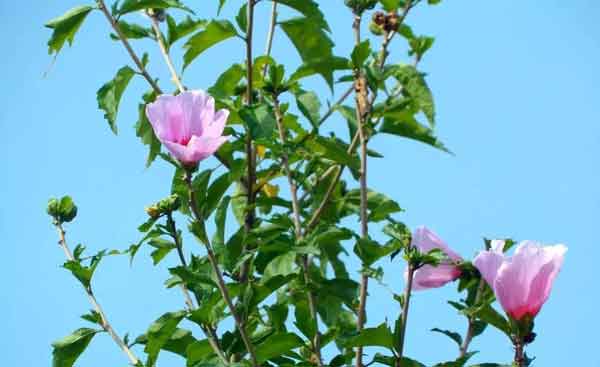
How to Care for Rose of Sharon (Althea Shrub)
Rose of Sharon Lighting
Rose of Sharon will grow well in full sun or part shade. For best flowering and overall performance, we suggest a minimum of 6 hours direct sunlight.Rose of Sharon Soil Care
Hibiscus Syriacus prefers well-drained clay soil that is rich in nutrients and humus, and not too dry. The substrate should be slightly acidic to alkaline. Poor, acidic sandy soils often result in weak flower formation and the shrub ages faster.Rose of Sharon Watering
Rose of Sharon prefers moist soil, especially during spring and summer. Water it frequently to increase the number of flowers. On the other hand, too much water can damage the plant. If you notice that the leaves are turning yellow, it doesn't mean the plant needs more water. Instead, you have been overwatering it. Rose of Sharon is drought tolerant and can survive a short period without water. Rose of Sharon will not be harmed in any way. Return to your watering schedule, and the rose of Sharon will continue to grow, producing large and colorful flowers as usual.Rose of Sharon Temperature & Humidity
A heat lover, Rose of Sharon is also prized by growers in the southeastern U.S. who seek plants that can stand up to summer's heat. Rose of Sharon is also tolerant of a wide range of humidity conditions.Rose of Sharon Fertilizer
Rose of Sharon need a fertilizer high in potassium (K), low in phosphorus (P), and with a medium amount of nitrogen (N)—too much phosphorus will kill a hibiscus. Hibiscus also respond well to an organic fertilizer, and a good layer of compost once a year is generally sufficient. Don’t fertilize after July as this can push new growth that will be damaged by frost.Rose of Sharon Pruning
Rose of Sharon flowers are produced on new wood, so prune in early spring to shape and reduce size. Pruning the shrub back to 2 to 3 buds per branch in spring encourages larger flowers. Remove dead, diseased, and injured branches any time.Although naturally multi-stemmed, Althea-Rose of Sharon can be trained through pruning (in late winter) to a single main trunk.Rose of Sharon Pests & Diseases
Rose of Sharon is susceptible to flower bud drop, which happens when soil moisture levels fluctuate widely. Regular watering helps prevent this. Leaf spot, a common fungal disease that affects althea, can be treated with a sulfur plant fungicide. Sulfur fungicides are available as a fine powder, which you dust over the leaves. You can also mix the dust with water at a rate of 3 tablespoons per 1 gallon of water and apply it with a garden sprayer. Apply the dust or spray every 10 to 14 days, as needed. Althea is relatively pest-resistant but it is sometimes bothered by aphids or spider mites. To control the pests, spray the plant with a ready-to-use insecticidal soap spray until all leaf surfaces are covered. Repeat every seven to 10 days, until the infestation is under control. Neither fungicides nor insecticidal soap should be used when temperatures are above 90 degrees Fahrenheit, or when the sun is shining directly on the plant. Wear eye protection, protective gloves, long sleeves, long pants and sturdy shoes when applying garden chemicals.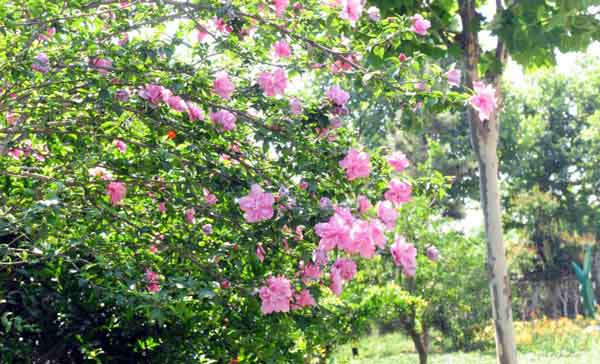
Rose of Sharon Varieties
Rose of Sharon ‘Lil' Kim' is a dwarf rose of Sharon with red, purple or white blooms. It matures at 3 to 4 feet tall and wide. The leaves are small, so you see a lot of colorful blooms as opposed to foliage. The flowers often last up to three days, while most rose of Sharon blooms fade after just one day.Rose of Sharon ‘Purple Pillar' rose of Sharon is a beauty with semi-double, purple-pink flowers with red throats. It tops out at 10 to 16 feet tall but only grows 2 to 3 feet across, so it's a good choice for narrow spaces.
Rose of Sharon 'Lavender Chiffon' rose of Sharon is striking with its semi-double, light purple petals marked with red veins. It grows 8 to 10 feet tall, so it can be used as a small tree; just leave the central leader and remove the other branches.
Rose of Sharon 'White Chiffon' rose of Sharon is a fine choice for a moon garden, where its pure white blooms, when planted with other light-colored flowers and foliage, will reflect the moonlight. It matures at 6 to 8 feet tall.
Rose of Sharon‘Blue Satin' Chiffon has nearly true-blue petals set off by yellow stamens and splashes of red in the flowers' throats. This nearly seedless variety is sometimes sold as 'Azurri Blue Satin' and reaches 8 to 12 feet in height.
Pruning and Maintenance
Pruning is optional unless you want to make your flowers bigger or train your shrub to grow a single trunk.
To avoid stressing the plant, all pruning should be done in the winter or early spring when it is fully dormant.
In general, plants bloom more abundantly but with smaller flowers when very light pruning is applied, whereas heavier pruning results in fewer but larger flowers.
If you want to shape your plant like a tree, pruning may be necessary during the first winter. You can wait until the second year if growth is not very significant.
Simply cut all stems except one straight down to the ground if you want to develop a habit that resembles a tree. You should choose a leader stem that is more centrally located and has some side branches. Do this every year to keep it in good shape.
Remove only diseased or dead branches for a lighter pruning. A third of the wood should be removed annually for heavier pruning, with older and weaker branches receiving special attention.
Never prune your plant more than one-third at a time to avoid damaging its health.
In order to tip the scales more in favor of producing smaller, more numerous flowers, each branch can be pruned back to leave no more than three buds. Branches that are sick or dead need to be pruned back to the ground or the stem's base.
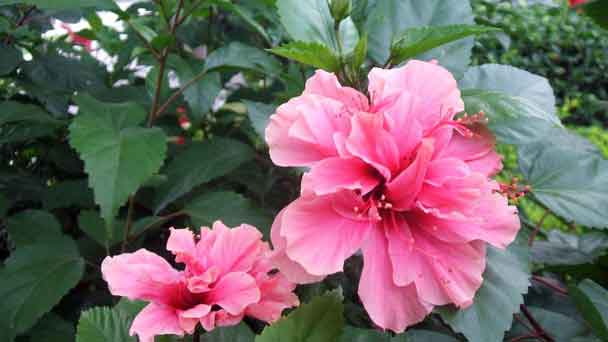
Managing Pests and Disease
Pests may from time to time bother Rose of Sharon, especially if plants are stressed or do not have ideal growing conditions. I'll discuss the principal offenders here.
Insects
My preferred method of preventing pests from getting out of hand is to encourage beneficial insect populations in my garden, while applying the principles and techniques of integrated pest management.
If you do have a serious infestation that needs to be treated, the insect pests listed below can typically be controlled with a solution of insecticidal soap and neem oil.
One teaspoon of neem oil, one third of a teaspoon of insecticidal soap or biodegradable dish detergent, and one liter of warm water should be combined to make one liter of spray.
Always test your spray on a few plant leaves and wait 24 hours before looking for damage. This may appear as discoloration or "burning" of the foliage, wilting, or desiccation.
Aphids
Aphids are notoriously destructive sap suckers that develop on stem tips or leaves.
They leave behind a spotty, depressing mess as they consume the plant. Furthermore, they leave behind the sticky honeydew, which traps fungal spores and may aid in the spread of fungi-related diseases.
With weekly sprayings of the aforementioned mixture, aphids can be best managed.
See our guide to learn more about how to control aphids in your garden.
Japanese Beetles
For treating these tiny, metallic-green beetles with bronze or copper-brown wings, sprays might not be as efficient. Skeletized leaves or flowers are a surefire sign of a Japanese beetle infestation.
Beetles can also be manually removed from plants and dipped in soapy water as an alternative to spraying, or plants can be covered with nets in the months of July and August, when beetle activity is at its highest.
Beneficial nematodes may be effective, and milky spore, available from Nature Hills Nursery, can also be used to kill the pests in their grub stage from October to March.
Milky Spore
You can learn more about controlling Japanese beetles in your garden in this guide.
Whiteflies
Similar to the closely related aphid, whiteflies are tiny white flies that can frequently be seen sucking sap from the undersides of leaves.
The affected leaves may wilt and have a pale or yellow color. Take off and discard the damaged leaves. Spraying the aforementioned mixture on infested plants at least once a week is recommended.
Disease
Leaf spot, rust, and root rot are the three most typical ailments that could affect rose of Sharon plants. Fungicides with a copper base can be used to treat all of these fungi infections.
Leaf Spot
Leaf spot first manifests as circular lesions or spots on foliage that are yellow or brown, and as the condition worsens, leaves eventually start to fall off. It's usually caused by Cercospora or Phyllosticta species of fungi.
Remove and destroy all infected plant material before beginning treatment. Then apply the fungicide to the entire plant as well as the soil around it, extending at least a foot beyond the dripline.
Keep your plants well-weeded to ensure they receive adequate airflow, and think about pruning to remove extra branches and improve airflow. Only water the plant's base, and make sure to regularly prune any diseased or dead branches.
Root Rot
The best way to avoid root rot, which is brought on by various fungi, is to make sure that plants have adequate soil drainage.
A suitable fungicide application program may be effective despite the limited number of treatment options. To learn more about preventing and treating it, check out our in-depth article on root rot here.
Rust
Rust, caused by the fungus Kuehneola malvicola, is a common problem for members of the It has a rust-like appearance and belongs to the Malvaceae family.
The leaves develop orange spots, which typically start on the underside of the leaves. Rust can be unsightly and slow plant growth, though it is not usually fatal.
As previously mentioned, treat similarly to leaf spot.
Rose of Sharon (Althea Shrub) FAQ
How Big Does a Rose of Sharon Get?
The Rose of Sharon grows to a height of 8–12' and a spread of 6–10' at maturity.What is the Lifespan of a Rose of Sharon?
A cold-hardy, drought-resistant shrub, Rose of Sharon can productively produce blooms for 20 to 30 years.Are Rose of Sharon Tree Roots Invasive?
However, Rose of Sharon can grow up to 12 feet high and can spread out, so rose of Sharon should not be planted close to septic tanks or drainpipes. Though Rose of Sharon's red, pink, white or purple flowers can be vibrant and beautiful, rose of Sharon is considered to be an invasive plant.Latest Updated
- Benefits of Bugleweed - 7 Science-backed Health Benefits
- Bugleweed Dangers & Side Effects - Is It Poisonous?
- How to Plant Evergreen Trees - What You Should Know
- When to Plant Evergreens - Grow Guide for Evergreen Trees
- 12 Wonderful Evergreen Shrubs for Your Garden
- 12 Popular Evergreen Plants with Pictures for Beginners
- When And How To Prune A Lilac Bush Like a Pro
- How to Grow & Care for Lilac Vine (Hardenbergia Violacea)
- Japanese Lilac Tree (Syringa Reticulata) Care & Propagation Guide
- Shumard Oak Pros and Cons - What to Know
Popular Articles
- Winter maintenance of Antirrhinum Majus
- How to Grow Terminalia Mantaly Tree
- How to Grow and Care for Crossostephium Chinense
- How to grow Antirrhinum Majus in spring
- Peristeria Elata (Dove Orchid) Profile: Info & Care Guide
- Underwatered Snake Plant (Sansevieria Trifasciata) - Signs And How To Fix
- How to Care for Brazilian Jasmine Plant (Mandevilla Sanderi)
- How to Grow & Care for Graptopetalum Purple Delight in Summer
- Rosa Chinensis (China Rose): Plant Growing & Care Tips
- How to Care for Baby Sun Rose (Aptenia Cordifolia)